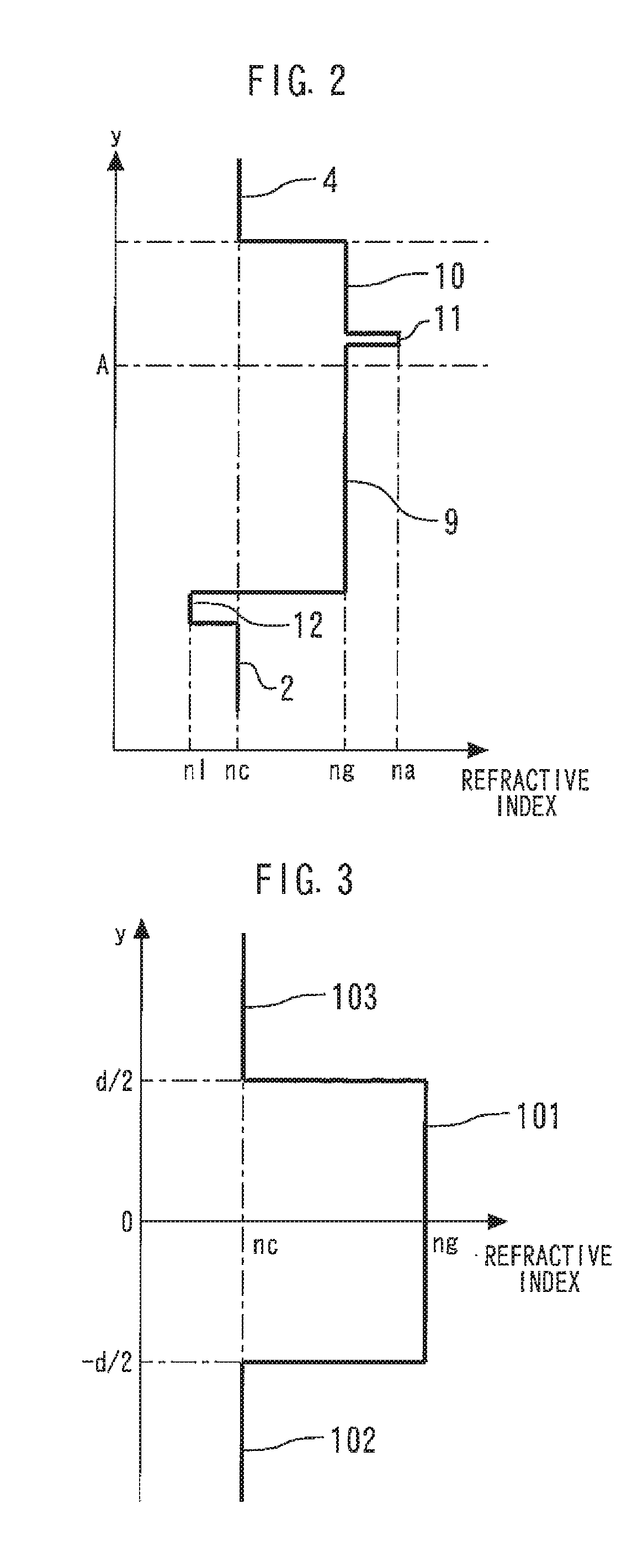Semiconductor laser device
a laser device and semiconductor technology, applied in semiconductor lasers, lasers, electrical equipment, etc., can solve the problems of limited improvement of power conversion efficiency during high output power, and achieve the effect of improving power conversion efficiency and high output power
- Summary
- Abstract
- Description
- Claims
- Application Information
AI Technical Summary
Benefits of technology
Problems solved by technology
Method used
Image
Examples
first embodiment
[0041]FIG. 1 is a cross-sectional view illustrating a semiconductor laser device according to a first embodiment of the present invention. An n-type AlGaAs cladding layer 2 having an Al composition ratio of 0.250 and a layer thickness of 1.5 μm is formed on an n-type GaAs substrate 1. A light guide layer 3 is formed on the n-type AlGaAs cladding layer 2.
[0042]A p-type AlGaAs cladding layer 4 having an Al composition ratio of 0.250 and a layer thickness of 1.5 μm is formed on the light guide layer 3. A p-type GaAs contact layer 5 having a layer thickness of 0.2 μm is formed on the p-type AlGaAs cladding layer 4.
[0043]A SiN film 6 having a film thickness of 0.2 μm is formed on the p-type GaAs contact layer 5. A p-type electrode 7 is formed on the SiN film 6 and electrically connected to the p-type GaAs contact layer 5 through an opening of the SiN film 6. An n-type electrode 8 is formed on a rear surface of the n-type GaAs substrate 1.
[0044]The light guide layer 3 includes an n-side A...
second embodiment
[0058]FIG. 8 is a cross-sectional view illustrating a semiconductor laser device according to a second embodiment of the present invention. The light guide layer 3 of the present embodiment includes a first light guide layer 13 formed on the n-type AlGaAs cladding layer 2, and second light guide layers 14 and 15 formed on the first light guide layer 13. The active layer 11 is formed between the second light guide layers 14 and 15. The first light guide layer 13 is AlGaAs having an Al composition ratio of 0.210. The second light guide layers 14 and 15 are AlGaAs having the same Al composition ratio of 0.190. The sum of a layer thickness dn2 of the second light guide layer 14 and a layer thickness dp of the second light guide layer 15 is 450 nm and is smaller than a layer thickness 750 nm of the first light guide layer 13.
[0059]The sum of layer thicknesses of the first light guide layer 13 and the second light guide layers 14 and 15 is 1200 nm. Note that the refractive index of AlGaAs...
third embodiment
[0062]FIG. 11 is a cross-sectional view illustrating a semiconductor laser device according to a third embodiment of the present invention. A p-type AlGaAs low-refractive-index layer 16 having an Al composition ratio of 0.600 and a layer thickness of 40 nm is formed between the light guide layer 3 and the p-type AlGaAs cladding layer 4. The rest of the configuration is similar to that of the first embodiment.
[0063]FIG. 12 is a diagram illustrating a refractive index distribution along a crystal growing direction in the vicinity of the active layer of the semiconductor laser device according to the third embodiment of the present invention. The p-type AlGaAs low-refractive-index layer 16 has a lower refractive index nl2 than the refractive index nc of the p-type AlGaAs cladding layer 4. Note that the refractive index of AlGaAs having an Al composition ratio of 0.600 with respect to light having a wavelength of 915 nm is 3.1846.
[0064]As described in the first embodiment, the insertion...
PUM
 Login to View More
Login to View More Abstract
Description
Claims
Application Information
 Login to View More
Login to View More - R&D
- Intellectual Property
- Life Sciences
- Materials
- Tech Scout
- Unparalleled Data Quality
- Higher Quality Content
- 60% Fewer Hallucinations
Browse by: Latest US Patents, China's latest patents, Technical Efficacy Thesaurus, Application Domain, Technology Topic, Popular Technical Reports.
© 2025 PatSnap. All rights reserved.Legal|Privacy policy|Modern Slavery Act Transparency Statement|Sitemap|About US| Contact US: help@patsnap.com



